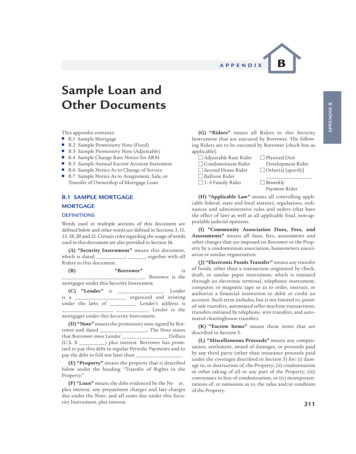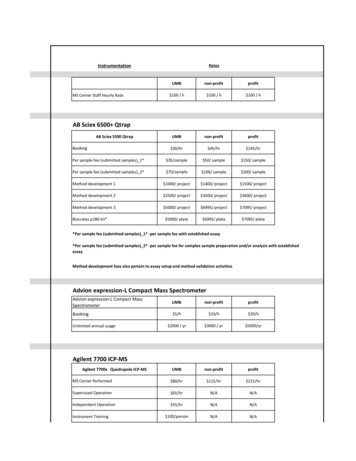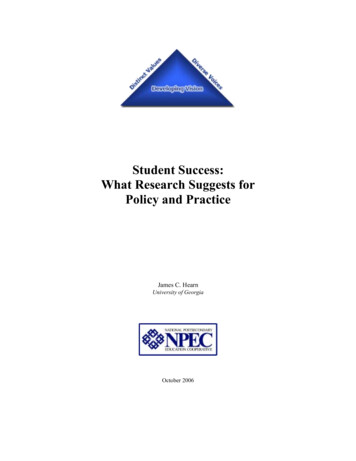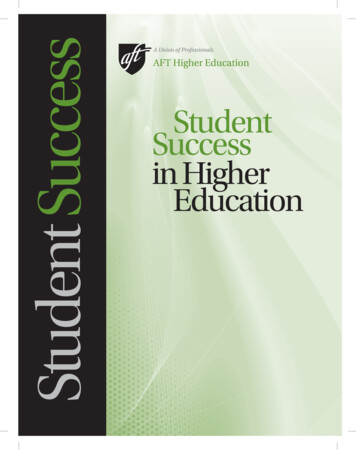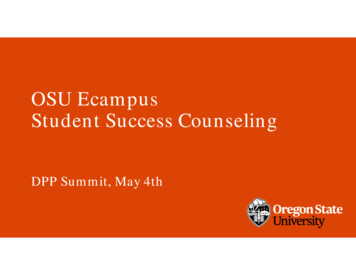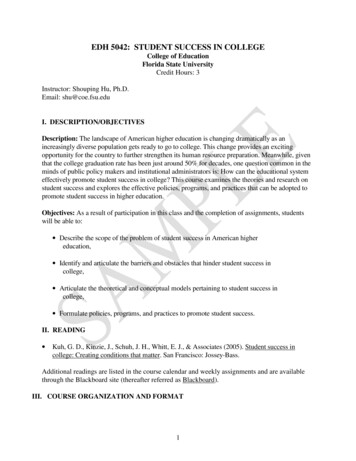
Transcription
EDH 5042: STUDENT SUCCESS IN COLLEGECollege of EducationFlorida State UniversityCredit Hours: 3Instructor: Shouping Hu, Ph.D.Email: shu@coe.fsu.eduI. DESCRIPTION/OBJECTIVESDescription: The landscape of American higher education is changing dramatically as anincreasingly diverse population gets ready to go to college. This change provides an excitingopportunity for the country to further strengthen its human resource preparation. Meanwhile, giventhat the college graduation rate has been just around 50% for decades, one question common in theminds of public policy makers and institutional administrators is: How can the educational systemeffectively promote student success in college? This course examines the theories and research onstudent success and explores the effective policies, programs, and practices that can be adopted topromote student success in higher education.Objectives: As a result of participation in this class and the completion of assignments, studentswill be able to: Describe the scope of the problem of student success in American highereducation, Identify and articulate the barriers and obstacles that hinder student success incollege, Articulate the theoretical and conceptual models pertaining to student success incollege, Formulate policies, programs, and practices to promote student success.II. READING Kuh, G. D., Kinzie, J., Schuh, J. H., Whitt, E. J., & Associates (2005). Student success incollege: Creating conditions that matter. San Francisco: Jossey-Bass.Additional readings are listed in the course calendar and weekly assignments and are availablethrough the Blackboard site (thereafter referred as Blackboard).III. COURSE ORGANIZATION AND FORMAT1
The course is designed comparable to the face-to-face offering of the same course. Students areexpected to complete tasks equivalent to two class meetings every week. The course week beginson Monday and ends on Sunday. Weekly assignments are due by 5pm Monday afternoon.Contacting the Instructor: The instructor, as well as the TA will be available via email to answerquestions (email addresses on page 1). Emails can be sent anytime and will be answered aspromptly as we can.IV. EQUIPMENTEach student will need a computer with Internet access and access to FSU’s Blackboard to takethis course.V. TOPICAL COURSE OUTLINEAs a general guide to planning, students should follow the posted schedule, but the course schedulemight vary based on class participants’ interests. The course schedule will be subject to alterationat intervals throughout the course. Updates to the general schedule will be issued throughout thesemester and available on the Blackboard website.Week1-ATopicIntroductionReading Course Overview: Review Syllabus andAssignmentsNational Commission on the Future ofHigher Education (2006). A test ofleadership: Charting the future of U.S.higher education. Washington, DC: USDepartment of Education. (Blackboard)Quiz 1 Swail, W. S., Redd, K. E., & Perna, L. W.(2003). Retaining minority students inhigher education: A framework for success.ASHE Higher Education Report, Volume30, Number 2. San Francisco: Jossey-Bass.(pp. 1-88) (Blackboard) Kuh, G. D., Kinzie, J., Buckley, J., Bridges, Discussion 1B., Hayek, J. (2007). Piecing together thestudent success puzzle: Research,propositions, and recommendations. ASHEHigher Education Report, Volume 32,Number 5. San Francisco: Jossey-Bass. (pp.1-67) (Blackboard) Kuh, G. D., Kinzie, J., Buckley, J., Bridges, Quiz 2B., Hayek, J. (2007). Piecing together thestudent success puzzle: Research, 1-BStudentSuccessImperative2-AWhat Mattersto StudentSuccess2-BWhat Mattersto StudentSuccessAssignment DueSelf-Introductionon DiscussionBoard2
nt.)4-ARethinkingabout StudentSuccessRethinkingabout StudentSuccessInstitutionalActions forStudentSuccess4-B5-Apropositions, and recommendations. ASHEHigher Education Report, Volume 32,Number 5. San Francisco: Jossey-Bass. (pp.68-end) (Blackboard)Discussion 2 Kuh, G. D., Kinzie, J., Schuh, J. H., Whitt,E. J., & Associates (2005). Student successin college: Creating conditions that matter.San Francisco: Jossey-Bass. (pp. 1-172) Kuh, G. D., Kinzie, J., Schuh, J. H., Whitt,E. J., & Associates (2005). Student successin college: Creating conditions that matter.San Francisco: Jossey-Bass. (pp. 173-317)Book Review of Students reflect on readings and work onKuh et al (2005)the scholarly paper. Students reflect on readings and work onthe scholarly paper. Tinto, V., & Pusser, B. (2006). Moving from Scholarly Papertheory to action: Building a model forinstitutional action for student success.National Postsecondary EducationCooperative symposium on studentsuccess. (Blackboard)Discussion 3Swail, W. S., Redd, K. E., & Perna, L. W.(2003). Retaining minority students inhigher education: A framework for success.ASHE Higher Education Report, Volume30, Number 2. San Francisco: Jossey-Bass.(pp. 89-end) (Blackboard)Students reflect on readings and work onthe final project.5-BInstitutionalActions forStudentSuccess(Cont.) 6-AProjectPresentation& CourseSumming-upProjectPresentation& CourseSumming-up 6-B Students reflect on readings and work onthe final project.VI. TEACHING STRATEGIESClasses will be a mixture of assignments and discussion (via BlackBoard).3Project report andPowerPointPresentation
Use of a web-supported format through the Blackboard environment is integral to the delivery ofcourse content. Each student is required to have an FSU email address to access materials on thewebsite.Course announcements, assignments, documents, and other course materials will be posted onthe Blackboard site for this course. Please consult the site periodically to stay informed.VII. EXPECTATIONSStudents are expected to complete all assignments and participate in all weekly discussions forthe course.VIII. ASSIGNMENT AND GRADING Engaged learning activities (40 points): To promote student engagement in the on-linelearning process, a variety of activities are planned for this class. As indicated in classschedule, two quizzes (8 points each) and three discussions (3 points each) will be given forthis class. The quizzes will be closely related to assigned readings and the discussionquestions will be somewhat related to the two major written assignments (Scholarly paperand Policy/Program project). Specific guidance will be provided with the quiz/discussionquestions. In addition, each student is to write a short review (3-5 pages, double space) of theKuh, et al’s book (2005) that summarizes the key points and offers some critiques (15points). Scholarly paper (25 points): Given that student population on campus is diverse in manyaspects, the challenges and obstacles to success may vary. In this scholarly paper, students areexpected to choose a specific student population (e.g., racial minority student; low-incomestudent; commuting student; part-time student; adult student; international student; studentathlete, etc.) to write a paper ( approximately 8-12 double-spaced pages, plus a reference list)in relation to college success for that student population. In this paper, the following aspectsneed to be addressed: 1) The definition and the context of college success for the selectedpopulation, and a justification for the needs of attention; 2) Factors related to the success ofthe chosen student population; 3) How various groups (e.g., state policy makers, academicadministrators, student affair professionals, etc.) should address the problems to promotecollege success for this special student population. Note: This assignment focuses on ONEGROUP OF STUDENTS and discusses what matters for their success and how theeducational community can help them succeed. Policy/Program project and presentation (35 points): The topic for the project is intendedto focus on policy, program, and practice and toward the function unit. That is, students areexpected to choose an academic or administrative unit within the higher education system todiscuss exemplary practice and/or innovative ideas that can be adopted to promote successfor all students. A written report (approximately 8-12 double-spaced pages, plus a reference4
list, counted as 25 points) and a presentation (an effective PowerPoint presentation of 10-15slides, counted as 10 points) are required for this assignment. The following aspects shouldbe addressed in this project: 1) The description of the unit of choice, including its missionand responsibilities; 2) The tasks and challenges facing this unit in promoting studentsuccess; 3) Existing programs and possible innovative strategies and ideas that can beadopted to promote student success, and the possible problems in implementing thoseprograms and strategies. It is permissible if there are some but not substantial overlaps in thewritten contents between this assignment and the scholarly paper. Note: This assignmentfocuses on ONE ORGANIZATIONAL UNIT and what this unit can do to help (one ormore groups of) students succeed. General grading guidance: a) 10% per day “policy”: Due date for the assignment isavailable in the class schedule at the beginning of the semester. So plan your workaccordingly. Unexcused late work will drop student scores on the assignment by 10% perday; b) APA editorial style in writing: Students are expected to follow the most recentedition of the APA editorial style in all written assignments for this class. Other editorialstyle can be accepted only with the consent of the instructor; c) Final grade will be assessedon the accumulative scores earned from all class assignments. Final grade will be assessedaccording to the following scale: IX.93 – 10090 – 9287 – 8984 – 8680 – 8377 – 7974 – 7670 – 7367 – 6963 – 6660 – 62Below 60AAB BBC CCD DDFHONOR CODEStudents are expected to uphold the Academic Honor Code published in The Florida StateUniversity Bulletin and Student Handbook. The Florida State University Academic Honor Policyoutlines the University’s expectations for the integrity of students’ academic work, theprocedures for resolving alleged violations of those expectations, and the rights andresponsibilities of students and faculty members throughout the process. Students areresponsible for reading the Academic Honor Policy and for living up to their pledge to “. . . behonest and truthful and . . . [to] strive for personal and institutional integrity at Florida StateUniversity.” (Florida State University Academic Honor Policy, found athttp://dof.fsu.edu/honorpolicy.htm.)5
X.ADA REQUIREMENTSStudents with disabilities needing academic accommodation should:(1) register with and provide documentation to the Student Disability Resource Center; and(2) bring a letter to the instructor indicating the need for accommodation and what type. Thisshould be done during the first week of class.This syllabus and other class materials are available in alternative format upon request.For more information about services available to FSU students with disabilities, contact the:Student Disability Resource Center874 Traditions Way108 Student Services BuildingFlorida State UniversityTallahassee, FL 32306-4167(850) 644-9566 (voice)(850) 644-8504 .fsu.edu/XI.SELECTED BIBLIOGRAPHYAdelman, C. (1999). Answers in the toolbox: academic intensity, attendance patterns, andbachelor’s degree attainment. Washington, DC: Office of Educational Research andImprovement, U.S. Department of Education.Adelman, C. (2006). The toolbox revisited: paths to degree completion from high schoolthrough college. U.S. Department of Education. Washington, DC: Office of Vocational andAdult Education.Allen, W. R. (1992). The color of success: African-American college student outcomes atpredominately white and historically black public colleges and universities. HarvardEducational Review, 62, 26-44.Astin, A. W. (1984). Student involvement: a developmental theory for higher education. Journalof College Student Development, 25, 297-308.Astin, A. W. (1993b). What matters in college? four critical years revisited (1st Ed.). SanFrancisco: Jossey-Bass.Baxter Magolda, M. B. (2001). Making their own way: narratives for transforming highereducation to promote self-development. Sterling, VA: Stylus.Bean, J. P. (1985). Interaction effects based on class level in an exploratory model of collegestudent dropout syndrome. American Educational Research Journal, 22, 35-64.6
Bowen, H. (1977). Investment in learning: the individual and social value of american highereducation. San Francisco: Jossey-Bass.Braxton, J. M., Hirschy, A. S., and McClendon, S. A. (2004). Understanding and reducingcollege student departure. San Francisco: Jossey-Bass.Braxton, J. M., Milem, J. F., and Sullivan, A. S. (2000). The influence of active learning on thecollege student departure process: toward a revision of Tinto’s theory. Journal of HigherEducation, 71, 569-590.Cabrera, A. F., Casteneda, M. B., Nora, A., and Hengstler, D. (1992). The convergence betweentwo theories of college persistence. Journal of Higher Education, 63,143-164.Chang, M. J. (1999). Does racial diversity matter? the educational impact of a racially diverseundergraduate population. Journal of College Student Development, 40, 377-395.Gumport, P. J. (2001). A report to stakeholders on the condition and effectiveness ofpostsecondary education. Change, 33(3), 27-42.Hearn, J. C. (1987). Impacts of undergraduate experiences on aspirations and plans for graduateand professional education. Research in Higher Education, 27, 119-141.Hossler, D., Schmit, J., and Vesper, N. (1999). Going to college: how social, economic, andeducational factors influence the decisions students make. Baltimore: Johns Hopkins UniversityPress.Hu, S. (2005). Beyond grade inflation: grading problems in higher education. San Francisco:Jossey-Bass.Hu, S., and Kuh, G. D. (2002). Being (dis)engaged in educationally purposeful activities: theinfluences of student and institutional characteristics. Research in Higher Education, 43, 555575.Hu, S., and Kuh, G. D. (2003). Maximizing what students get out of college: testing a learningproductivity model. Journal of College Student Development, 44, 185-203.Hurtado, S., Carter, D. F., and Spuler, A. (1996). Latino student transition to college: assessingdifficulties and factors in successful college adjustment. Research in Higher Education, 37,135-157.Hurtado, S., Milem, J. F., Clayton-Pedersen, A. R., and Allen, W. R. (1999). Enacting diverselearning environments: improving the climate for racial/ethnic diversity in higher education.ASHE-ERIC Higher Education Report 26, No. 8. Washington, DC: The George WashingtonUniversity, School of Education and Human Development.7
Kuh, G. D. (1993). In their own words: what students learn outside the classroom. AmericanEducational Research Journal, 30, 277-304.Kuh, G. D. (1995). The other curriculum: out-of-class experiences associated with studentlearning and personal development. Journal of Higher Education, 66, 123-155.Kuh, G. D. (1996). Guiding Principles for Creating Seamless Learning Environments forUndergraduates. Journal of College Student Development, 37(2): 135-148.Kuh, G. D. (2001). Assessing what really matters to student learning: Inside the National Surveyof Student Engagement. Change, 33(3): 10-17, 66.Kuh, G. D., and Hu, S. (2001). The effects of student-faculty interaction in the 1990s. Review ofHigher Education, 24, 309-332.Kuh, G. D., Kinzie, J., Buckley, J., Bridges, B., Hayek, J. (2007). Piecing together the studentsuccess puzzle: Research, propositions, and recommendations. ASHE Higher Education Report,Volume 32, Number 5. San Francisco: Jossey-Bass.Kuh, G. D., Kinzie, J., Schuh, J. H., and Whitt, E. J. (2005). Student success in college: creatingconditions that matter. San Francisco: Jossey-Bass.National Commission on the Future of Higher Education (2006). A test of leadership: Chartingthe future of U.S. higher education. Washington, DC: US Department of Education.Nora, A., and Cabrera, A. F. (1996). The role of perceptions in prejudice and discrimination andthe adjustment of minority students to college. Journal of Higher Education, 67, 119-148.Pascarella, E. T. (2001). Cognitive growth in college: surprising and reassuring findings. Change,33(6), 20-27.Pascarella, E. T., and Terenzini, P. T. (1991). How college affects students: findings and insightsfrom twenty-years of research (1st ed.). San Francisco: Jossey-Bass Publishers.Pascarella, E .T., and Terenzini, P. T. (2005). How college affects students: a third decade ofresearch. San Francisco: Jossey-Bass.Perna, L. W., and Titus, M. A. (2005). The relationship between parental involvement as socialcapital and college enrollment: an examination of racial/ethnic group differences. Journal ofHigher Education, 76, 485-518.Swail, W. S. (with Redd, K. E., and Perna, L. W.). (2003). Retaining minority students in highereducation: a framework for success. ASHE-ERIC Higher Education Report No. 2. Washington,DC: The George Washington University, School of Education and Human Development.8
Tinto, V. (1987). Leaving college: rethinking the causes and cures of student attrition. Chicago:University of Chicago Press.Tinto, V. (1993). Leaving college: rethinking the causes and cures of student attrition. (2nd ed.).Chicago: University of Chicago Press.Tinto, V. (1997). Classroom as communities: exploring the education character of studentpersistence. Journal of Higher Education, 68, 599-623.Venezia, A., Kirst, M. W., & Antonio, A. L. (2003). Betraying the college dream: Howdisconnected K-12 and postsecondary education systems undermine student aspirations.Stanford, CA: Stanford University Bridge Project.Zhao, C. M., and Kuh, G. D., (2004). Adding value: learning communities and studentengagement. Research in Higher Education, 45, 115-138.9
effectively promote student success in college? This course examines the theories and research on student success and explores the effective policies, programs, and practices that can be adopted to . 1-A Introduction Course Overview: Review Syllabus and Assignments National Commission on the Future of Higher Education (2006). A test of

